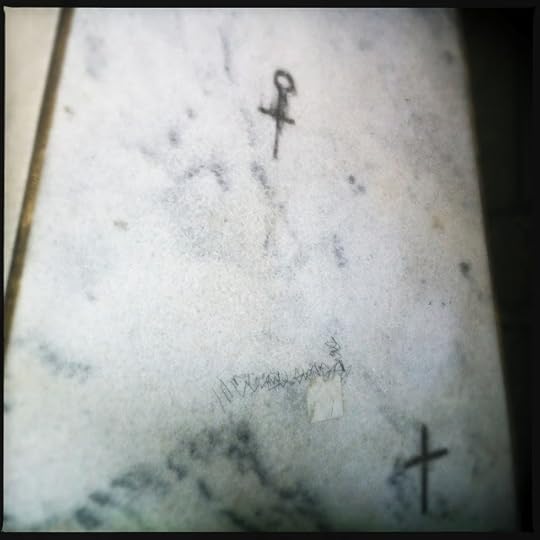Every Life is Symbolic, Not Real
 Graffiti on the Cultural Education Center (15 February 2012)
Graffiti on the Cultural Education Center (15 February 2012)On the squared marble column of the building I work in, at the far right of the bank of doors that opens its body to the world, I found today a congeries of rough-hewn graffiti, two bold characters separating an asemic squiggle.
The large characters, each dramatically awry and the topmost written too high for anyone standing on the ground to write, were not characters of any language, but symbols distributing meaning and associations in loud thunks.
Each also resembles the letter t, each replicating the cross.
The lower symbol is, clearly, the cross, a crucifix, a Christian symbol that represents Christianity, Jesus Christ, even the resurrection, itself being the assignment of positive meaning to a simple drawing of a gory instrument of death by slow torture.
The upper symbol almost stands in contradiction to the first: it is the symbol of Venus, woman, and the malleable metal copper, concepts in contradistinction (if not, sometimes, conflict) with Mars, man, and iron.
As the cross represents Jesus (thus, in Christian extension, god), it also represents man, the godhead being given to us as a male being, and the elongation of its vertical line, a spike.
The version of the symbol for woman that we are provided here, however, carries a long spike, which might make us think of the symbol as hermaphroditic, except that there is a separate symbol for that, which combines the male symbol with this on, topping the circle of the symbol with a pointed spike.
The symbolism of the spike is obvious.
But the symbol for woman is less so: the circle represents the spirit (the circle, possibly, representing an awelike O, the expiration of breath from the body), and the cross (which is meant to be square, each line of identical length) represents matter, thus exhibiting solidity, stability.
The extra length of the vertical in this version of the woman gives this symbol a resemblance to the ankh, or crux ansata, the symbol of life (that is, eternal life), thus giving this found text a reverberation between the two symbols, the cross always representing Christ's promise of eternal life.
(Although everyone is granted eternal life in the Christian view—it is merely that some are promised a happy one, and others one of eternal torment.)
The crux ansata was also thought by some to represent the male and the female in one, something alluded to here by the length of that spike.
Between these two symbols on the flat western face of this column, there runs a faint scribble of illegible text, the visual equivalent of gibberish.
Between the woman and the male, the corporeal and the spiritual, the upper and the lower, the human and the god, there persists conflict, misunderstanding, an inability to connect, the pure unalloyed beauty of whatever cannot be interpreted precisely.
ecr. l'inf.
Published on February 15, 2012 20:52
No comments have been added yet.



